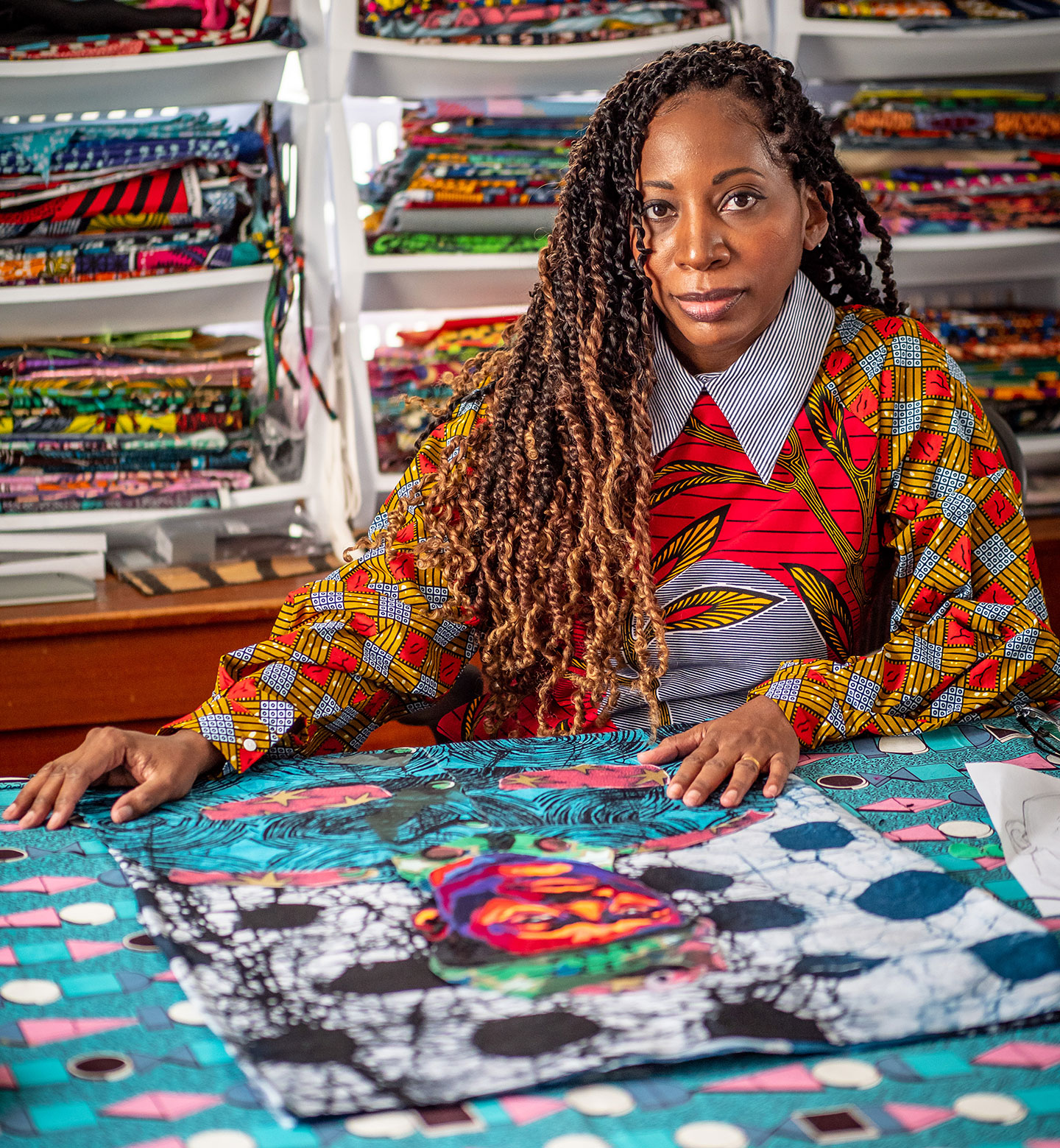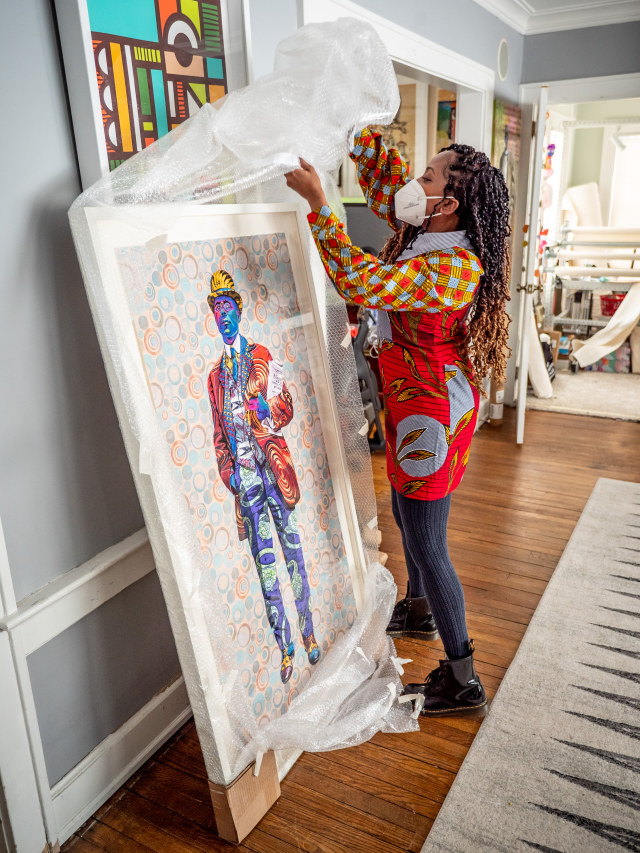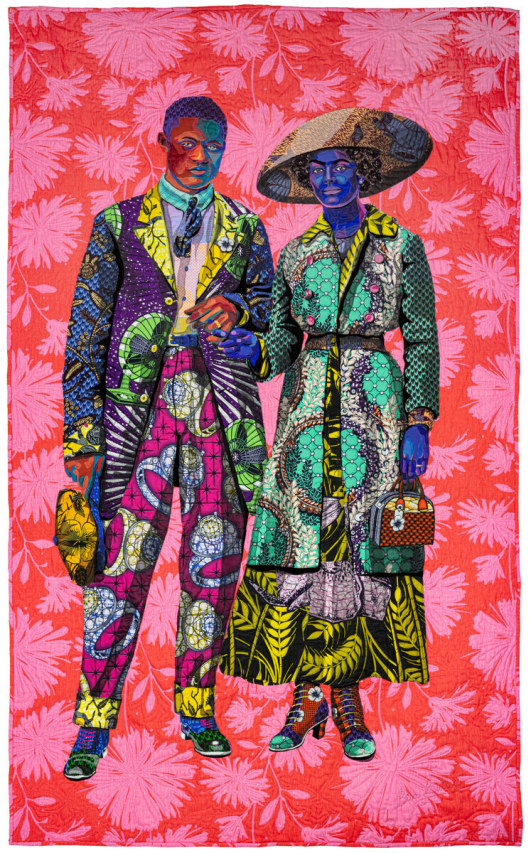
The Art of the Quilt
Bisa Butler ’05
Textile artist’s quilts tell stories of the human condition through intricate patterns
“I use these fabrics to help communicate the story I am trying to tell.” –Mailissa “Bisa” Yamba Butler ’05 MAT
Mailissa “Bisa” Yamba Butler’s art career has soared in the past year, capped by a solo show at the prestigious Art Institute of Chicago, where 22 of her works are on exhibit until September 6, 2021. Butler’s unique technique involves reappropriating vintage photographs and giving them new life through a traditional folkloric medium – quilting. Her work engages with themes of family, community, migration, history, creativity and promise using a variety of material including velvet, cotton, wool, silk and West African kente cloth. Here, Butler, who graduated with a Master of Arts in Teaching in 2005, answers our questions about her “whirlwind” year and the many decades of work behind it.
Montclair magazine: Tell us about your technique, using photographs and giving them new life through the medium of quilting. Beyond the technical side, what does the tradition of quilt making mean for you and for your art?
Bisa Butler: Quilt making is one of the truly American art forms. When I quilt I feel like I am carrying the torch that was lit by my ancestors. There was a tradition of making fabric appliqué artworks in the ancient kingdom of Dahomey (present day Benin) where you will find brightly colored cloths with images of animals and people stitched onto them. Enslaved African Americans made quilts for their own families using the designs and patterns reminiscent of African textiles and passed on this tradition to their children. Although my direct relatives were not quilters to my knowledge, I feel that I am carrying on this tradition from ancestors unknown.

Montclair: Your portraits include famous people but often feature the unnamed, the forgotten. The man in I Am Not Your Negro is as regal and deeply layered as Frederick Douglass in The Storm, the Whirlwind, and the Earthquake. Tell us about that.
Butler: The man pictured in I Am Not Your Negro was sourced from a photo by Dorothea Lange for the Farm Securities Administration. I was drawn to his thoughtful gaze and pose and it made me curious about this contemplative man. It is the mystery and the soul of an image that draws me in – I want to know more. When you encounter Frederick Douglass’ images you can see his defiance, pride and fierce convictions. We are lucky to know his story – but what about those who weren’t so lucky? I am curious about the human condition in all forms and lifestyles. I believe we are all deeply layered – and beautiful in our own ways and that is what I want to portray. If I can make someone’s innate beauty stand out, I feel I have done my job.
Montclair: There seem to be hidden stories in the fabric patterns you choose for the clothing in your subject matter. The fabrics feature globes, airplanes, rings, snakes, electric fans. What does it all mean?

Butler: I use many African textiles that are designed by African and Dutch designers. This cloth is called “Dutch Wax” or “African Wax Print.” The images are often inspired by African folktales, sayings and allegories. For instance, the fabric printed with an electric fan indicates that the wearer is wealthy. If you have an electric fan in your shop in the marketplace it would mean that you have more money to pay for that convenience. The fan indicates economic prosperity. There is another fabric that is printed with stools all over it. This fabric is called “If you want to talk about me, you may as well pull up a stool” or in other words, “I don’t care about your gossip.” I use these fabrics to help communicate the story I am trying to tell about my subjects.
Montclair: The colors in your work are so vibrant, from the patterns of the clothing to the play of light and shadow across faces.
Butler: I use color as a way of expressing emotion. I use warm hues like red, orange and yellow to express passion and happiness, while I may use blues and purples to express more somber moods. I also use colors seen in African textiles – electric blue, lime green and rich scarlet reds all at the same time. I portray African Americans and I want to infuse and adorn them with the colors of the continent.
Montclair: You have had quite the year or so – with more major museums exhibiting and purchasing your work, and your portrait of 2004 Nobel Peace Prize winner Wangari Maathai featured as one of 100 covers produced as part of Time magazine’s 100 Women of the Year – the most influential women of the past century. How does success feel?

Butler: I feel incredibly thankful and happy that I get to experience moments of success – it has been a long road. Although I must say that I felt very successful as a high school art teacher and was proud of what I was doing. I dreamed that one day I might be able to make a living making my artwork and I’m so glad it actually happened.
It’s easier for me to get work done now because I can work for hours on end in my studio – whereas before I would have to stop because I had to get up early in the morning!
Montclair: The Toledo Museum of Art purchased your portrait of Frederick Douglass. What does this mean for you?
Butler: I am always thrilled when an artwork I have made finds a new home. The Toledo Museum of Art is an incredible institution and to have my artwork join their historic collection is thrilling. I am so happy that people appreciate what I am doing, and I am doubly honored that my rendition of Frederick Douglass can represent such an important person.
Montclair: How did your studies at Montclair State shape you as an educator and an artist?
Butler: I made my first quilt while I was attending Montclair State. My Fibers professor, Kerr Grabowski, instructed us on the basics of quilt making and I decided to make a portrait of my grandparents for my final assignment. That was the moment when I realized I could use my love of sewing and textiles – and combine that with my drawing and painting skills in order to make art.
Montclair: Your father, A. Zachary Yamba, served as president of Essex County College for three decades, bringing enormous growth to the college. How did he influence your path?
Butler: My father always taught me and my siblings to do our best at whatever it was we put our minds to. He used to say, “If you are a street sweeper, be the best street sweeper!” To this date he still advises me and edits my essays. As a teacher, I knew that I had to try my best to make every student have a positive experience while they were in my class. As an artist I still feel that I have a responsibility to put my best effort forward with each piece.
Montclair: What advice would you give students today?
Butler: I would advise students to pursue what you love, and don’t be afraid of hard work. It is OK to struggle, it is OK to get tired – as long as you keep going. Set goals for yourself and don’t quit until you get them. Success may not come easy or quickly but that is OK – the struggle will make you stronger and better.